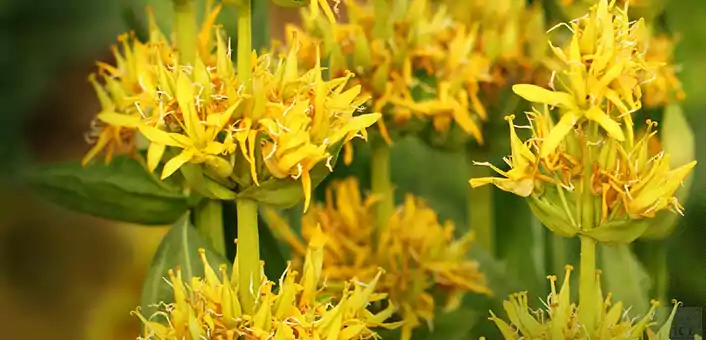
Acid Reflux
Picrorhiza Kurroa: A Traditional Ayurvedic Herb For Stomach Ulcers
Jul 19, 2017Picrorhiza kurroa (Yellow Gentian) is a rare herb that grows in the harsh Himalayan regions
at altitudes of 3000 to 5000 meters. The herb has been used in Ayurvedic and Chinese medicines for treating a variety of health conditions, including those of the liver and upper respiratory tract, as well as a treatment for fevers, dyspepsia and chronic diarrhea. It is also used for treating the toxic effects of scorpion stings.
Picrorhiza kurroa For Acid Reflux: The Background
Acid is a painful condition affecting close to 6 million Americans every year. Uncontrolled acid reflux can lead to chronic conditions like GERD and peptic ulcers. Ulcers happen when the stomach lining gets damaged, and small holes can lead to bleeding. Conventional medications for GERD and ulcers can do more harm than good in the long run.
Given the shortcomings of conventional medications for GERD, there has been a renewed interest among patients as well as mainstream medical practitioners in alternative and traditional therapies for the condition. This has put the focus back on natural herbs and supplements that have been used for the treatment of digestive conditions since centuries. Picrorhiza kurroa is one such herb, which has been used for centuries for digestive health.
Picrorhiza kurroa: What Does Research Say?
The active compound found in Picrorhiza is called kutkin. The herb also contains other bioactive compounds such as apocyanin and drosin. All of these compounds are potent antioxidants and also offer anti-inflammatory benefits.
Stomach ulcers can be caused either by an H. pylori infection or due to a pharmacological problem (overuse of NSAIDs). In such a scenario, the immune system sends neutrophils along with other cells to counter the infection or to contain the damage done to the mucosal lining of the stomach by drugs like NSAIDs. Neutrophils can cause further tissue damage by releasing potent compounds. The ulcer-healing and stomach protective effects of Picrorhiza come in handy to inhibit inflammation caused by neutrophils as well as oxidative effects of substances.
Picrorhiza also has a liver-protecting effect, which is attributed to the potent antioxidative properties of its various chemical constituents. It can also help treat viral hepatitis, which if left untreated, can cause long-term damage to the liver.
Picrorhiza can also help in regulating digestion by activating the secretion of bile acids and salts from the liver. In a low gastric acid environment, the secretion of digestive juices is impaired, leading to improper digestion of food and further aggravation of acid reflux.
How Do I Get Picrorhiza?
Picrorhiza has been a major income-generating plant in the Himalayan region. Traditional Nepalese and Laddakhi gatherers have been collecting this shrub for centuries. These herbs are then supplied (in a largely unorganized manner) to Ayurvedic practitioners or manufacturers of Ayurvedic formulations.
Due to the continuous gathering of the herb from natural habitats and with little or no cultivation, Picrorhiza was declared as an Endangered Species in 1997. Another species called Picrorhiza scrophulariifolia, a non-endangered variety and with a similar bioactive chemical profile as of P. kurroa, is used nowadays as a substitute.
Dried rhizome (roots) is available commercially. Many Ayurvedic formulations like Yakrit Plihantak Churna (to treat liver and digestive ailments) contain Picrorhiza.
Is Picrorhiza Safe?
Picrorhiza kurroa can cause vomiting, itching, anorexia, rashes and itching. Due to its immune-modulating effects, it may worsen autoimmune conditions making it unsafe for those suffering from such conditions. Pregnant and lactating mothers should also avoid taking Picrorhiza.
How Much Picrorhiza Helps?
Picrorhiza kurroa is a very powerful herb and should be taken only under the advice of a medical practitioner (trained in Ayurveda, preferably). Usually, for digestive ailments, the dosage is between 0.5 to 1 gm per day. Higher dosages should be avoided as Picrorhiza shows purgative activity at higher doses.
Picroliv, a combination of picroside 1 and picroside 2 (two potent chemical constituents of Picrorhiza) is active at a dosage of 12 mg/kg body weight.
Final Verdict on Picrorhiza kurroa
Picrorhiza kurroa (kutki) exceeds silymarins in potency. Although it remains under-researched by Western medicinal standards, its use for more than 5000 years by the ancient Indian medical science of Ayurveda attests to its benefits.
It is a potent liver-protectant and protects against toxic effects of alcohol, Tylenol and even the dreaded deathcap mushroom.
Ayurvedic formulations and supplements (like Picroliv, or Picrolax, which is a laxative) made using Picrorhiza are available. And yet, since it is a very potent and powerful herb, it should be used only under the guidance and advice of a trained medical practitioner.




